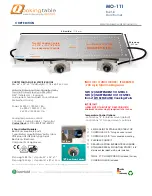
Page 16 of 26
(Vers.12.17.2018)
S
-
100 Refractory Walled Air Curtain Burner with HATZ 3H50TIC Diesel Engine
OPERATING MANUAL
LOADING AND STARTING THE FIREBOX
To minimize
start
-
up
smoke you can:
Use your driest materials.
Ensure your materials do not retain dirt or sand.
Use diesel fuel to accelerate the light up.
COLD START LIGHTING
1.
The air should be off and the engine should be
running, but the PTO should be disengaged.
2.
For best results and quickest light up, start the fire
from the bottom because fire will spread upwards
much
better than it will spread downwards.
3.
Use a propane torch (like a weed burner) or oil
soaked rags on poles to light the fire.
4.
The fire can be started from under the rear doors
and from the access door in the forward panel on
the manifold side of the unit.
Access door for lighting
If you are using diesel fuel as a starter, let the fire burn until you begin to see wisps of
white smoke replacing the wisps of black smoke from the diesel fuel or, if you are using
propane torches, wait until the fire has strengthened and flames are reaching the top of
the firebox. Then engage the air at 1,400 RPM. As the fire burns stronger, increase the
air (approximately 200 RPM every 15 minutes) up to maximum.
Don
’
t increase the air too quickly as you can
“
blow
”
the fire out. If you add air and the
smoke gets heavy, then reduce the RPM and let the fire
“
catch
-
up.
”
Once it clears up
you can slowly increase the air again.
Sometimes it is helpful to
“
fan
”
the fire during the start
-
up phase. You accomplish this
by increasing the RPM for 3 to 8 minutes, then decreasing it (i.e. 1,400 RPM up to
2,000 RPM and back down to 1,400 RPM). This sometimes helps to spread the fire
throughout the material. How much air to add and when to add it during startup will
vary with the type of materials being burned.







































